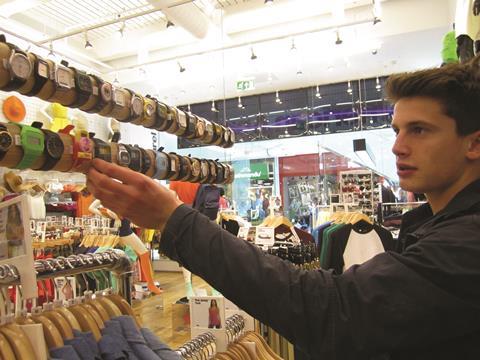Today’s teenagers are growing up amid a digital revolution, and retail has some work to do if it’s going to keep up.

Today’s 14 to 19 year olds, known as Generation Z, are growing up in a very different world to anyone born before 1995.
Not only has the political and economic climate changed fundamentally, but in the past few years there has been an explosion in digital technology that few expect to see repeated.
As Alasdair Lennox, creative director at design agency Fitch, which has produced a report on Generation Z, says: “The past three to four years have been quite amazing in terms of technological breakthroughs. Will it have changed as dramatically in another 10 years? I struggle to believe that it will have the same level of intensity of innovation in coming years. It’s quite hard to keep this trajectory of technological innovation.”
That makes today’s teenagers the first generation of shoppers to naturally use technology many others need to adapt to.
There are other developments affecting this age group’s outlook. Obama’s tenure as America’s first black President means they are used to and respond well to images of diversity in marketing and media, according to Fitch. The global downturn, meanwhile, means they are suspicious of credit. Having grown up with the effects of elder generations’ credit splurges, they are keen savers and careful purchasers.
Fitch’s report on Generation Z says: “While instant gratification in shopping was the norm for Generations X and Y, Generation Z are credit cynics. These resourceful savers are careful not to waste their limited financial means.”
But every generation is affected by its own political climate, so it’s the digital changes that probably hold the most resonance for retailers. As Karen Stenzel, who leads the global consumer products marketing team at Red Bull, says:“This younger generation are early adaptors so what they like to do will be standard in the coming years.”
Fitch’s report says: “Gen Z are not a new species. In many ways they’re just like the teens of previous generations but with new tools to express their identities, discover new information and influence their peers.” In 2004, when the youngest of this group was aged nine, Facebook was launched. In 2005, YouTube followed and in 2006 Twitter was unveiled. The iPhone followed in 2007 and since then the pace of development in digital and web technologies has been rapid. To someone turning 15 in 2013, using such services and devices is second nature, and in another few years they will be entering the workplace and earning more disposable income.
Rebuilding retail
So what does this mean for retailers? The first and most important step, according to Fitch, is a large one - brands need to reshape their infrastructure in a bid to remove silos and operate more seamlessly. The report states: “Retail organisations need to change fundamentally. It is impossible to achieve seamless retail if you have separate, silos departments for store design, online operations, marketing and logistics. The highly structured corporate silos within large retail organisations need to become more fluid and collaborative, to build future-ready infrastructures.”
Rebuilding a retailer is no mean feat, and Lennox says the required change needs to come from the top of the organisation. He says: “If the chief executive puts his or her head in the sand and says ‘I don’t understand these kids’, this won’t happen. As ever, great retail businesses will be driven by great leaders. They need to have a sense of who their future audience is.”
Retailers may want to consider employing a chief experience officer (CXO) whose job it is to oversee these newly seamless operations. Fitch’s report says: “Gen Z want nothing more than to share their data and information, but most
organisations currently are unable to receive it. The CXOs will not only gather and utilise that valuable feedback, but use it to build advocacy and loyalty.”
In addition to the operational changes, brands will also need to think carefully about their message and how they communicate it. Generation Z shoppers respond well to brands whose message is authentic, but are quick to cotton on to those that aren’t. Fitch’s report says: “Stores will need to offer compelling, brand-led experiences that are more about aspirational browsing and less about a direct push for transactions.”
Generation Z’s approach to shopping is different as well. These shoppers like to ‘find’ things - discover them through online platforms such as Facebook or Pinterest or via magazines or TV shows - before browsing and researching the product.
They are keen on creating digital scrapbooks of images taken in stores on smartphones or found online, and will carefully track prices before making a final decision.
They are also keen on sites such as eBay for purchasing, and once they have a product in their hands they want to shout about it. This age group was the first to produce ‘haul videos’ - uploading videos of themselves showing off their purchases - and they are more likely to talk about products on social networks.
Many of these changes retailers are already aware of and are working to cater for, but it’s clear that this new type of shopper will need a strategy and infrastructure all of its own. Authentic brands, clever digital technology, well-designed stores and seamless infrastructure will all need to feature widely in Generation Z’s retail world.
What should retailers consider doing?
- Hire a chief experience officer (CXO) so there is someone in change of the overall customer journey, and who can use data to improve the shopper’s experience. The CXO would also be responsible for the consumer experience strategy.
- Re-organise the business so departments can work together more seamlessly.
- Don’t underestimate the change that’s coming - it is not just marketing or talking differently to people.
- Don’t be afraid to open up to consumers in the early stages of product development.
- Make sure you stand for something - these shoppers will pick up on it if you don’t - and communicate that.
- Remember the store environment is important - brands often forget what they stand for in store.
- Be open and honest, especially about problems or mistakes.
- Research who your audience is and understand them through and through.
- Shift from offering new things to buy to inspiring new things to do, Fitch’s report advises, and from telling your brand’s story to finding out theirs.
Habits of Generation Z
- These teenagers are very confident and aware of trends.
- They want to be involved and are interested in what’s behind the scenes.
- They see through inauthentic brands and are hard to fool.
- They are early adapters to technology.
- They can be cynical but are also brand lovers - if they believe in what is being sold they will buy it.
- Gen Z don’t respond well to the hard sell. “They want two-way dialogue and mutual rewards,” Fitch’s report says.
- These shoppers “live in a constant state of partial attention, but will know about a product problem or promotion way before you do,” according to Fitch.
- They will prefer to see a half-completed product or service and have a say in its development than to wait for completed products. Starbucks’ project ‘My Starbucks Idea’ is a good example - it gives customers a chance to make suggestions on how to improve the coffee chain.


























No comments yet